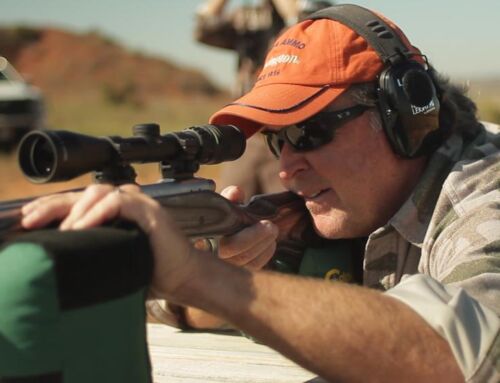You are miles from your truck trying to fill your last deer tag, or shed-hunting, or maybe just hiking in the snowy woods or mountains. Suppose you get turned around and it’s getting dark, or you slip and fall into a frozen stream…? At the very least you will be cold and miserable; at the very worst you could die. Never venture outside in the winter without an emergency fire plan.
Fire Gear
These essentials weigh next to nothing; carry them in a waterproof pouch in your pack.
Butane lighter: Old school was to carry some waterproof matches in a Baggie, and I still do that sometimes. But better is to pack a modern survival lighter, like the Cabela’s Alaskan Outfitter. It is waterproof, wind-proof, and has a big, easy-to-use ignition switch, something you need when sparking a fire with numb fingers and the cold shakes.
Tinder: This critical stuff jump-starts your fire. I carry a quart-size Baggie stuffed with a mix of shredded wax paper, dry leaves, dead grass, tiny sticks and the like. Most people overlook this, but you need dry tinder.
Paste: I often carry a tube of Coghlan’s Fire Paste. Squeeze some of the flammable gel on kindling and larger sticks wood. As the tinder ignites, the paste will fire and blow the wood into a fast, hot flame.
Build A Fire
In an emergency, you don’t have time to find the perfect fire site. Just think, “Out of the wind and dry.” Check the south side of a ridge or bluff that is out of a cold north or northwest wind. Plus, a southern exposure is warmed naturally by any sun that is out. Look for a thermal spot that is sheltered by evergreen trees, but remember back to your Boy Scout days—never build a fire under snow-laden branches. If you can find a sheltered spot near big rocks, they will help hold and reflect your fire’s heat and light.
With your boots, scuff out a huge spot (maybe six by eight feet) in wet dirt or snow. Clear enough dry ground not only for your fire pit, but also to stack your wood and keep it close and dry.
Most important step of all: Work fast before dark to gather enough kindling, small fuel (sticks thick as your fingers), larger fuel (thick as hot dogs) and finally logs that will burn for hours. In a survival situation, a big mistake that cold, scared people often make is to gather too little wood. If you use up your tinder and kindling but your fire burns out in 20 minutes or so, you’re in trouble.
Gather whatever dry wood that is close and available, but know that soft woods like fir, holly, and apple burn quickly and brightly and give off good heat. Other sticks that are easy to start in an emergency situation include birch, pine, elm, dogwood, and hemlock. Once your fire grows big and hot, add oak, maple, hickory, or other hardwood logs, which burn slowler and crumble into red embers that give off warmth for hours.
Obviously, the deader and drier the wood the better. Remember Scout rule #2: snap dead sticks and branches off standing trees and the tops of dead-falls.
I use a one-side anchor for a backcountry fire, generally a large log. I lay it perpendicular to any slight wind that is blowing at ground level. Then I lean a big, wide heaping of kindling wood against it (leave open holes so enough air is there to start a flame). I stuff a tinder ball beneath the kindling, pop my lighter on it and presto, instant flame. I keep adding lots of kindling and larger branches (with dabs of Fire Paste as needed) until I have roiling flames.
Again, I can’t stress enough how important it is to have a huge stack of dry wood at the ready and for the long run. As your fire grows, keep adding larger and larger fuel. Those big flames will keep you warm, dry you out, and give you the will to survive a cold, dark night if you have to.







All this is very true. It’s never a bad idea to carry fire making supplies. A Zippo lighter with a piece of bike ride around it makes a good water proof seal and Zippo’s are windproof.
Ouch Big Daddy. Good stuff to know and take with you. We all know it would never happen to us but…. Another neat trick I learned a few years back is to take an empty tuna can, coil a bunch of twine in it , leaving the tag end sticking out of the open top. Fill the can with melted parafin, pouring it over the twine and let it cool. Throw it in a small baggie and put it in our pack. You can start a fire in a rainstorm buy just putting the can in the bottom of your pit and then putting your tinder and wood on top. Light the twine wick sticking out of the can and it will burn for an hour. plenty of heat to dry and icnite wet tinder and kindling. Easy, cheap, and handy….justy the way I like it!
I never thought I’d use my “Metal Match” and waxed cotton balls I kept in a baggie in the bottom of my day pack. Just put them there ’cause some scribe had said to do so in an old Outdoor Life magazine I read as a kid 50 years ago. Then a few years back I was staying alone at my camp in upstate Pa. an walked out the cabin with no note or phone call to anyone as to where I was headed. Truth be told I didn’t know where I would end up at dark but I had hunted the area all my life and knew it well. Trouble was my rescuers whom needed to find me with a broken leg and ankle didn’t know where I was either.
I built my fire easily with those few items I had in my pack right next to an uprooted blow down and spent the night. When I didn’t call home by midnight I knew my wife would call the locals to report me missing. The group of old friends in the area of my cabin arrived at ten the next morning and hauled me out with an ATV .
You can bet a metal match and some waxed cotton balls along with a cell phone will be with me from now on. That November night would have been much longer without them.
Always remember Jack Londons guy who started a fire under the pine with his big bunch of matches (his Last ) to survive…………………………..